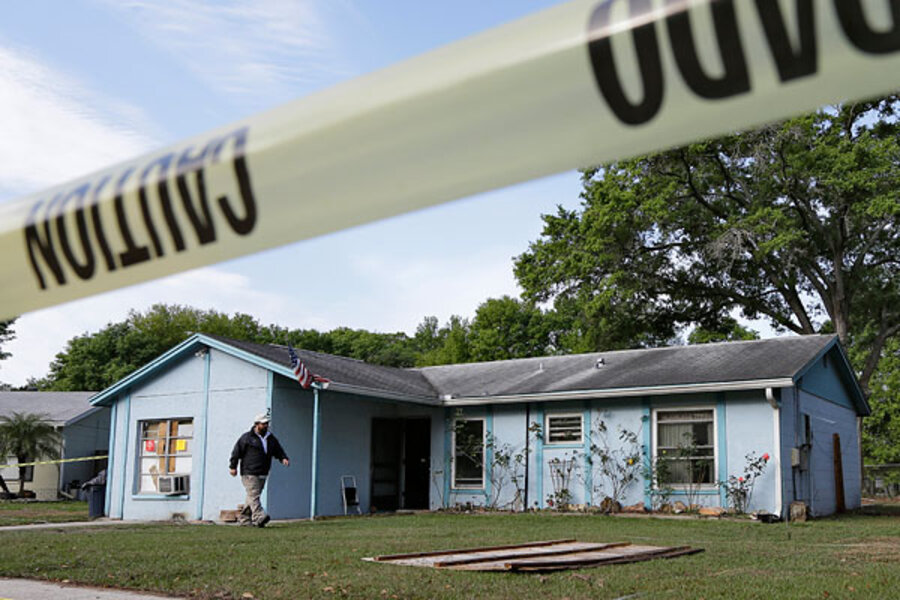Florida sinkhole swallows man: shocking start to 'sinkhole season'
Loading...
| ATLANTA
In an unusually dramatic and likely fatal start to Florida's annual sinkhole season, a Tampa man remains missing underground Friday after a massive sinkhole swallowed part of a house, including the man's bedroom, late Thursday night.
Five adults, a child, and two dogs were in the house when witnesses said it felt like a car hit the building. The victim's brother scrambled toward the bedroom to save his kin, but he himself had to be rescued by rescue workers.
A search was underway for the missing man Friday, but authorities said camera scopes inserted into the rubble-filled subterranean cavern showed nothing "compatible with life." The 30-foot-wide hole is part of a 100-foot-wide cavern. Search-and-rescue efforts were hampered by fears that a larger area around the house could collapse and potentially trap firefighters searching for the man.
Hundreds of sinkholes appear across Florida's sand-and-clay surface a year as underground limestone caverns collapse. Injuries and deaths, however, are exceedingly rare. Florida usually endures a "sinkhole season" in spring and early summer as heavy, rain-soaked surface soils press down on the roofs of limestone caves emptied of water by the winter dry season.
"This is the first time I've heard about somebody being hurt by a sinkhole," says Jonathan Martin, a geologist at the University of Florida in Gainesville. At the same time, he says, a collapse can happen "in minutes, and you can have a collapse that happens quickly and then stops for a while and continues."
Reports suggest the missing man was sleeping when the sinkhole opened.
Tony Randazzo, a former University of Florida geologist now at the consulting firm Geohazards, Inc., in Gainesville can remember two cases of sinkholes taking lives in Florida – one 10 years ago, another 40 years ago – both involving well drillers who died when sinkholes appeared under them as they worked.
"Losing a house to a sinkhole is very common, losing life is uncommon," he says. "Most people will have some warning of the pending doom or catastrophic collapse. You start seeing some cracks, unusual noises as the house loses support … but you usually have a few hours."
Over the last couple of years, sinkhole survivor stories tend to involve motorists in cities like Chicago, Milwaukee, and New York City, which have all seen massive sinkholes emerge under streets, in most cases caused by underground streams or leaking municipal water systems washing away the ground under roadways.
But given its particular geology, as well as busy human development and agriculture, Florida is the undisputed US sinkhole epicenter.
Last summer, a home in Hudson, Fla., began to slide into a sudden sinkhole, and became lodged like a cork in the ground.
In 2010, a Plant City woman, Carla Davis-Chapman was startled by a lizard in her yard and fell backward into a manhole-sized sinkhole, an experience she barely survived.
"Wet clay and sand falls on you, compresses you," she told a local TV station. "You can't maneuver out of it. You wriggle and maneuver into it."
Last spring, a large sinkhole appeared in a residential yard in Jonesville, Fla., near Gainesville, spooking the residents and leaving them searching for the possible cause.
"It's an eerie sound when you hear that dirt caving in," homeowner Robert Matheny told the Gainesville Sun.
Sinkholes, in fact, are so common in Florida that the insurance industry successfully lobbied the Florida Legislature in 2011 to change state law, making it much harder for property owners to recover damages from sinkholes. Previously, the cost to insurance companies had been increasing at "an extraordinary rate, because the legislature prevented companies from charging rates in line with the risk," Mr. Randazzo says.
Most sinkhole events take place along the I-4 corridor that runs from Clearwater through Orlando to Daytona. They often strike in developed areas, sometimes as a direct result of human activity, including construction, well drilling, and agricultural pumping.
"Subsurface erosion is difficult to trace and prediction of potential collapse areas is difficult to impossible," according to a research paper by Barry Beck, founder of the Florida Sinkhole Research Institute.
"Man's activities have accelerated the surface collapse of sinkholes in many instances," the paper said. "Technically speaking, man does not cause sinkholes, but he may activate them."





